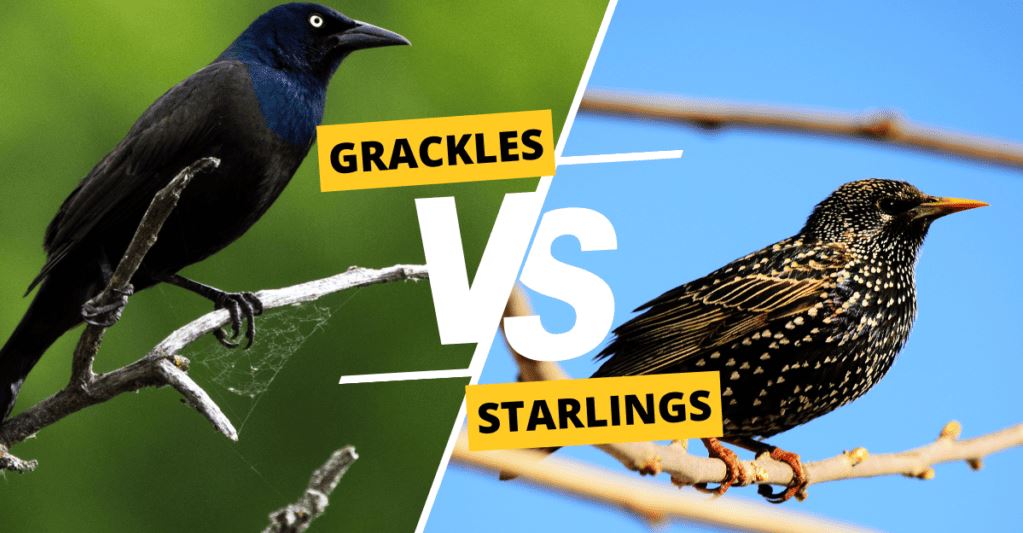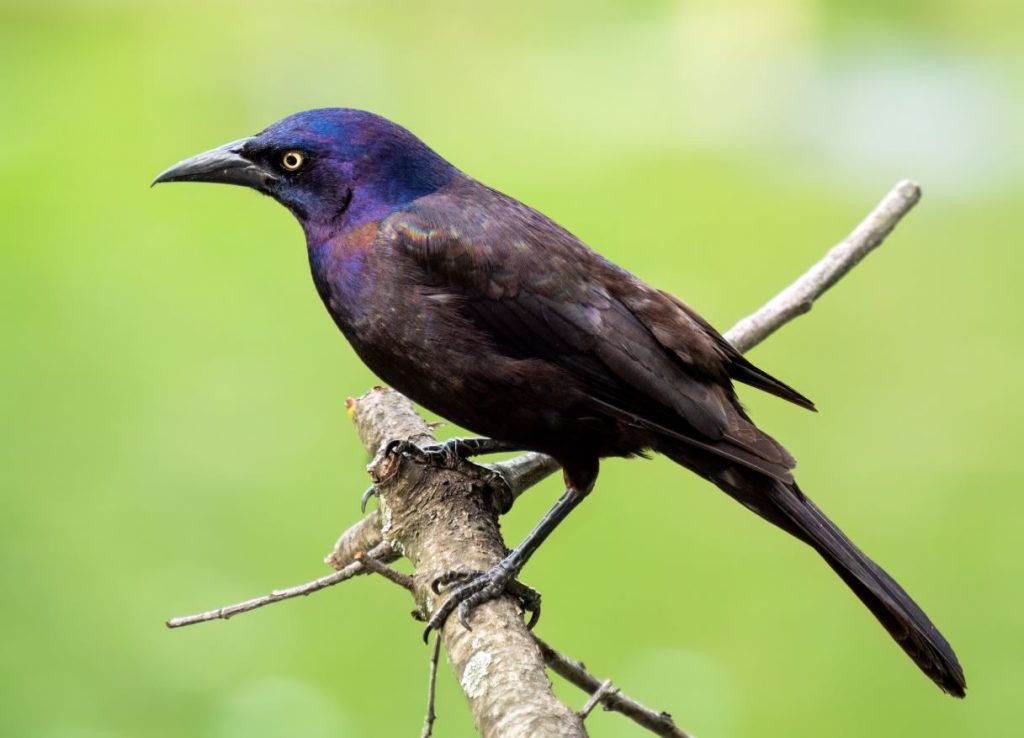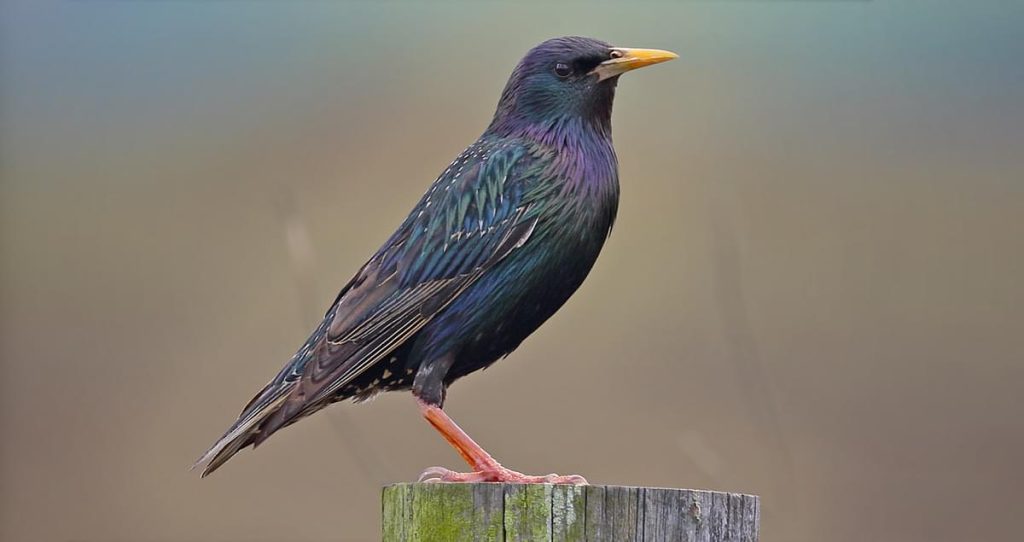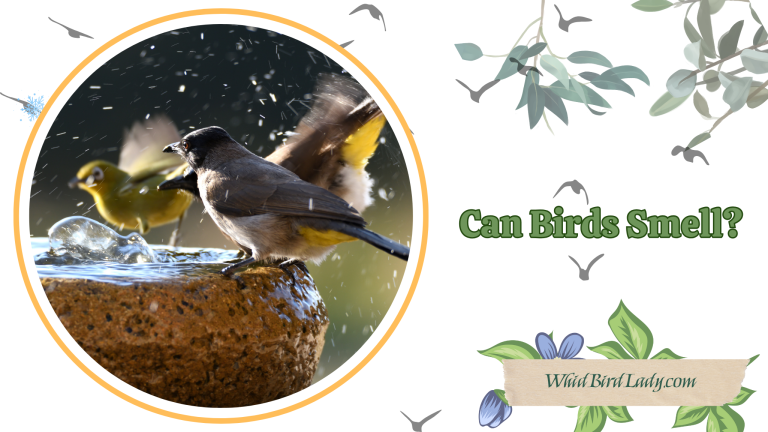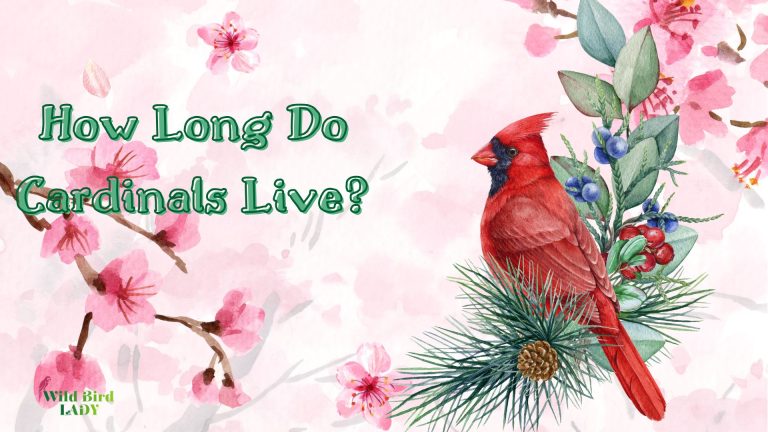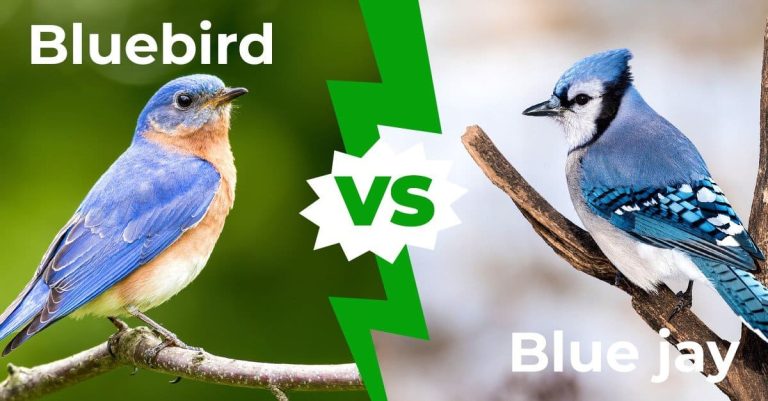Grackle vs Starling: How to Tell These Common Backyard Birds Apart
If you’ve ever looked out your window and spotted a glossy black bird with a loud, sharp call, you might have asked yourself—was that a grackle or a starling?
As someone who has spent over 13 years observing birds across North America, I’ve encountered this confusion countless times. Both birds are striking in appearance, widespread, and often travel in noisy flocks, especially in suburban or urban environments. But while they may seem similar at first glance, grackles and starlings are two very different species—each with their own behaviors, diets, vocalizations, and ecological impacts.
In this guide, I’ll break down the key differences and similarities between grackles and starlings to help you identify them with confidence.
Overview of Grackles and Starlings
Let’s begin with a quick introduction to each bird:
Grackle (Quiscalus spp.)
The most common species in the U.S. is the Common Grackle (Quiscalus quiscula), part of the blackbird family, Icteridae. Native to North America, grackles are known for their iridescent plumage, piercing yellow eyes, and strutting gait.
European Starling (Sturnus vulgaris)
Despite the name, European Starlings are now one of the most widespread birds in North America. Introduced in the 1890s by Shakespeare enthusiasts, they belong to the family Sturnidae and are considered an invasive species in the U.S. (Cornell Lab of Ornithology).
Physical Appearance: Plumage and Size
At a distance, both grackles and starlings may seem like your average “black bird,” especially when silhouetted against the sky or perching in the shadows. But as any seasoned birder knows, the devil is in the details. A closer inspection—especially in good lighting—reveals remarkably different physical traits that make each species unique.
Grackles: The Sleek, Iridescent Strutters
Grackles, especially the Common Grackle, are known for their sleek, elongated body shape and unmistakable iridescent plumage that shifts color depending on how the light hits it.
- Size: Adult grackles are relatively large for backyard birds, measuring 11–13 inches in length. Their size often surprises new birders who mistake them for crows from a distance.
- Wingspan: Ranges from 14 to 18 inches, giving them a commanding presence in flight.
- Plumage: A stunning mix of iridescent blue, green, bronze, and violet, particularly vibrant around the head and upper back. The body can appear bronzy or blackish depending on the individual and the light.
- Eyes: One of their most striking features—bright, piercing yellow eyes that stand out against their dark feathers and give them an intense, almost eerie stare.
- Tail: Long, keel-shaped (like the bottom of a boat), often forming a dramatic V-shape in flight, which makes them easy to spot overhead.
These birds often walk boldly and deliberately on the ground, almost strutting with purpose—another clue to their identity.
Starlings: The Speckled, Compact Performers
European Starlings, while smaller, are no less eye-catching. Though invasive, they are undeniably beautiful in their own way—particularly during the winter months when their feathers become speckled with white.
- Size: Much smaller than grackles, starlings typically measure 7.5 to 9 inches in length.
- Wingspan: Compact, ranging from 12 to 16 inches, which allows for tight, agile flight maneuvers—especially in murmurations.
- Plumage: In summer, their feathers appear metallic green and purple, though generally darker and less reflective than grackles. In winter, they are easily recognized by their white-tipped feathers, giving them a dotted or speckled appearance across the back and chest.
- Eyes: Deep dark brown to black, blending in with their plumage—unlike the bright eyes of a grackle.
- Tail: Short and squared, often barely extending beyond the wings when perched. In flight, the tail appears stiff and compact.
Unlike grackles, starlings often move in jerky, rapid steps when foraging and are far more likely to form tight, coordinated flocks, especially during colder months.
Key Tip for Birders:
If the bird has a long, V-shaped tail like a boat rudder and struts like it owns the yard—it’s probably a grackle. If it’s smaller, compact, has speckled feathers in winter, and flocks in high numbers—it’s likely a starling.
Lighting conditions matter—grackles look the most colorful during sunny mornings or golden hour. Meanwhile, starlings tend to blend in until you spot their speckles or hear their distinctive chatter.
Vocalizations and Behavior
As an experienced birdwatcher, one of the first things I listen for when identifying birds is their calls.
Grackles:
Grackles have a harsh, metallic, almost robotic call. It often sounds like a rusty gate or a squeaky hinge. They also make whistles and clicks.
Starlings:
Starlings are incredible mimics. They imitate other birds, alarms, and even car sirens. Their vocalizations are more melodic and warbling, with varied pitch and rhythm.
“The starling’s song is a dazzling performance of mimicry and melody.” – Cornell’s All About Birds
Habitat and Range
Both grackles and starlings are highly adaptive and opportunistic—traits that have helped them flourish in human-modified landscapes. Whether you’re in a bustling downtown, a rural cornfield, or a quiet suburb, chances are you’ll encounter one or both of these birds. But despite their overlapping territories, they occupy slightly different niches and exhibit unique habitat preferences.
Grackles: From Wetlands to Backyards
Grackles are native to North America, with the Common Grackle (Quiscalus quiscula) being the most widespread species.
- Geographic Range: Found primarily in the eastern and central United States, from southern Canada down through Texas and the Gulf Coast. During migration, some grackles travel as far south as Mexico.
- Preferred Habitats:
- Open woodlands: Especially along forest edges and clearings.
- Agricultural fields: Grackles are known to forage in corn, rice, and wheat fields, often in large numbers.
- Suburban neighborhoods and lawns: Commonly spotted walking across backyards, parking lots, and even schoolyards.
- Wetlands and water bodies: Grackles are particularly fond of areas near ponds, lakes, rivers, or marshes. Their affinity for water-rich environments distinguishes them from many other blackbirds.
- Nesting Sites: Grackles build nests in coniferous and deciduous trees, tall shrubs, or sometimes on human-made structures like light poles and ledges.
From my experience, you’ll almost always spot grackles around retention ponds or drainage areas in suburban developments, especially in the warmer months.
Starlings: Masters of the Urban Jungle
The European Starling (Sturnus vulgaris) is a non-native species introduced to New York City in the 1890s. Since then, they’ve spread rapidly across the continent, establishing themselves in nearly every type of human environment.
- Geographic Range: Now found across all of North America, from coast to coast and as far north as Alaska. They’re year-round residents in most parts of the U.S., with some northern populations migrating south in winter.
- Preferred Habitats:
- Urban areas and cities: Starlings are classic “urban exploiters,” thriving among skyscrapers, power lines, and public parks.
- Farmland and pastures: Frequently seen foraging among livestock, following tractors to snap up disturbed insects.
- City parks and suburbs: Take advantage of food scraps, lawns, and ornamental trees.
- Industrial zones: Flourish around factories, airports, and rail yards.
- Nesting Sites: What truly sets starlings apart is their love for cavities. They will nest in virtually any nook or cranny, including:
- Vents, ducts, building crevices
- Street lights and traffic signals
- Tree holes and abandoned woodpecker nests
- Signposts and utility boxes
I’ve personally seen starlings nesting inside the letter “O” of a supermarket sign and emerging from dryer vents on apartment buildings—they’re that resourceful.
Habitat Comparison Summary
| Feature | Grackles | Starlings |
|---|---|---|
| Native Status | Native to North America | Invasive (introduced from Europe) |
| Range | Eastern & Central U.S. | Entire North America |
| Preferred Environments | Wetlands, fields, wood edges, backyards | Cities, farms, parks, industrial zones |
| Proximity to Water | Often near lakes, rivers, marshes | Less dependent on water |
| Nesting Behavior | In trees and shrubs | In any cavity, natural or man-made |
Understanding where each bird prefers to live can dramatically improve your ability to identify them in the field. So next time you see a dark bird strutting through a mall parking lot or calling from a tree by a pond, think about the setting—it may offer your first clue to whether you’re looking at a grackle or a starling.
Feeding Habits and Diet
While both are omnivores and highly opportunistic, they forage in different ways.
Grackles:
- Eat insects, grains, seeds, fruit, and even small vertebrates
- Known for raiding crops and stealing food from feeders
- Will sometimes dip food in water before eating
Starlings:
- Eat insects, fruits, seeds, and garbage
- Often forage in lawns, using a “pry open” technique to uncover grubs
- Can decimate berry crops and compete with native birds for food
Fun Fact: A single flock of starlings can consume hundreds of pounds of insects or crops in a day.
Social Structure and Flock Behavior
Both birds are social, but starlings take it to another level.
Grackles:
- Travel in flocks, especially outside breeding season
- Can form mixed flocks with blackbirds or cowbirds
- Maintain loose hierarchies within groups
Starlings:
- Known for massive murmurations—synchronized aerial displays involving thousands of birds
- Highly coordinated and responsive to threats
- Communal roosting is common
As someone who’s seen starling murmurations at dusk, I can tell you—it’s one of the most breathtaking spectacles in the bird world.
Breeding and Nesting Differences
Grackles:
- Nest in dense trees or shrubs
- Females build the nests using twigs and grasses
- Lay 3–7 pale blue eggs
Starlings:
- Cavity nesters (often displacing native birds like bluebirds)
- Use anything from holes in trees to building crevices
- Lay 4–6 pale blue or white eggs
Because starlings are aggressive nest competitors, they often reduce local biodiversity—a major reason they’re considered invasive.
Ecological Impact: Native vs Invasive
Grackles:
- Native to North America
- Sometimes considered pests due to their crop damage and noise
- But they play a role in insect control
Starlings:
- Invasive species with serious ecological consequences
- Compete aggressively for nest cavities
- Known to displace native species like woodpeckers and swallows
According to the U.S. Fish and Wildlife Service, starlings cause tens of millions of dollars in agricultural damage annually.
Quick Identification Guide
| Feature | Grackle | Starling |
|---|---|---|
| Size | Larger (11–13 inches) | Smaller (7.5–9 inches) |
| Tail | Long and V-shaped | Short and square |
| Eyes | Bright yellow | Dark brown |
| Color | Iridescent blue/green/purple | Glossy black with winter spots |
| Call | Harsh, metallic | Warbling, mimicry-rich |
| Native Status | Native | Invasive |
| Nesting | Trees or shrubs | Cavities (often displaces natives) |
Frequently Asked Questions
1. Are grackles and starlings related?
No. Grackles are part of the blackbird family (Icteridae), while starlings belong to the Sturnidae family.
2. Which bird is more aggressive?
Starlings are generally more aggressive, especially during nesting season, and often evict native birds.
3. Do grackles and starlings flock together?
Sometimes. During migration or winter, they may form large mixed flocks with blackbirds and cowbirds.
4. Can starlings mimic human sounds?
Yes! Starlings are famous for mimicking speech, alarms, and even ringtones.
5. Should I discourage these birds from my backyard?
If you’re trying to attract native songbirds, limiting access to grackles and starlings may help. Use feeders that exclude larger birds and avoid open seed trays.
Final Thoughts: Grackle vs Starling—Now You Know
After more than a decade of birding, I’ve learned that the key to identifying birds like grackles and starlings lies in the details—the shimmer of feathers in the sun, the sound of their calls, the way they move across a field or perch on a wire.
Both birds are survivors and thrive in human-altered environments, but they leave very different footprints on the ecosystem. Recognizing them not only deepens your birdwatching experience—it helps you support local biodiversity, too.
If this guide helped you, consider exploring more tips and bird ID resources at Cornell’s All About Birds, one of the most trusted sources in ornithology.
Read also: Baby Starlings: Everything You Need to Know About These Young Songbirds

